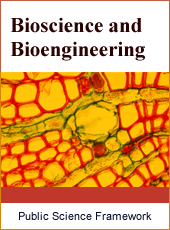Bioscience and Bioengineering
Articles Information
Bioscience and Bioengineering, Vol.1, No.2, Jun. 2015, Pub. Date: May 23, 2015
Biosorption of Zinc (Zn2+) and Iron (Fe2+) from Wastewater Using Botrydium Granulatum and Euglena Texta
Pages: 17-21 Views: 6477 Downloads: 2001
[01]
B. O. Olusola, Department of Microbiology, Faculty of Science, University of Ibadan, Ibadan, Nigeria.
[02]
M. N. Aransiola, Department of Microbiology, Faculty of Science, University of Ibadan, Ibadan, Nigeria.
One of the most serious environmental problems being faced by the world today is heavy metal pollution. Biosorption, being a cost-effective and efficient, has emerged as alternative technology for removal of heavy metals. The potential of two immobilized algae species for removal of Zinc (Zn2+) and Iron (Fe2+) from industrial wastewater was analysed through batch studies. Algal bloom water samples were obtained from fish ponds in Prof. Olu Odeyemi’s Farm, Ilesa. Wastewater was collected from industrial discharge system around Ile–Ife (Nigeria). Algae were isolated from the water samples using pour plate technique on modified Allen agar medium at pH 7.1. The identity of the algae isolates was established using Identification guide to Freshwater and Terrestrial algae. Algae were immobilized with 3% sodium alginate and 2% calcium chloride dihydrate. The beads of approximately 4mm were formed by allowing the algae/alginate mixture to drip through a syringe barrel in to a beaker of calcium chloride dihydrate solution. Biosorption batch studies was carried out by the addition of 100 beads into 100ml solution (50 ml of wastewater and 50 ml of media) in 250ml conical flask at 150rpm, room temperature and pH 3, 5 and 7. Concentration of Zinc (Zn2+) and Iron (Fe2+) was determined in 2 days interval using atomic absorption spectrophotometer at their respective detection limit. The algal isolates were identified as Botrydium granulatum and Euglena texta. The percentage removal of Zinc (Zn2+) and Iron (Fe2+) (at their respective detection limit) by these algae varies with pH and time. At pH 5, Botrydium granulatum had the best percentage removal rate (100%) (that is not detectable in the wastewater) for the two metals while Euglena texta performed best (100%) at pH 3 and 5 for the two metals over the period of time. At pH 7, the percentage removal of the two metals decreases with time for both algae species. At pH 5, Euglena texta performed better by complete (100%) removal of both metals starting from day 1 while Botrydium granulatum completely (100%) remove Iron (Fe2+) and Zinc (Zn2+) starting from day 7 and 5 respectively. Zinc (Zn2+) was more effectively removed than Iron (Fe2+) by Botrydium granulatum at pH 5. Since the algae isolates showed appreciable sorption of the metals, they can be used for biosorption of metals from industrial wastewater prior to its discharge to avoid environmental pollution.
Biosorption, Botrydium Granulatum, Immobilization, Wastewater, Zinc (Zn2+)
[01]
H. Eccles, Treatment of metal-contaminated wastes: Why select a biological process?, Trends Biotechnol., 17, 1999, 462-465.
[02]
S. K Mehta and J.P. Gaur, Use of algae for removing heavy metal ions from wastewater: progress and prospects, Crit. Rev. Biotechnol., 25, 2005, 113-152. DOI:10.1080/07388550500248571
[03]
K. Ramakrishna, Ligy Philip, Bioremediation of Cr (VI) in contaminated soils, Journal of Hazardous Materials, B121, 2005, 109-107.
[04]
A. Lopez, N. Lazora, A. M. Marques, The interphase technique: a simple method of cell immobilization in gel-beads. J. Microbiol. Meth, 30, 1997, 231-234.
[05]
L. Brinza, M. J. Dring, M. Gavrilescu, Marine Micro and Macro-algal species as biosorbents for heavymetals, Environment Engineering Management Journal, 6, 2007, 237-51.
[06]
W. G. Garnham, G. A. Codd, and M. G. Gadd, Accumulation of Cobalt, Zinc and Manganese by esturine green Chlorella salina immobilized in alginate microbeads, Environmental Science Technology, 26, 1992, 1764-70.
[07]
M. S. Abdel Hameed, Continuous removal and recovery of metals by alginate beads, free and alginate immobilized chlorella vulgaris, Africal Journal of Biotechnology, 5, 2006, 1819-23.
[08]
D. M. John, B. A. Whitton, A. J. Brook, The freshwater Algal Flora of the British Isles. An identification guide to Freshwater and Terrestrial Algae (Cambridge University Press and Natural History Museum, Cambridge, 2002)
[09]
I. J. Tinsely, Chemical concept in pollutants behavior (John wiley and sons Inc. New York, 1979, 56 – 58).
[10]
I. Walinga, V. Van, and J. J. Vanderlee, “Plant Analysis procedures” (Wageningen Agricultural Units, Soil and Plant Part 7, A Series syllabi, Netherlands. 1989, 10 – 167).
[11]
L. E. Chojnacka, R. O. Canizares, S. Baena, Efficiency of ammonia and phosphorus removal from a Colombian agroindustrial wastewater by the microalgae Chlorella vulgaris and Scenedesmus dimorphus, Bioresour. Technol., 60, 2004, 259–262.
[12]
S. K. Mehta, and J. P. Gaur, Characterization and optimization of Ni and Cu sorption from aqueous solution by Chlorella vulgaris, Ecol. Engin., 18, 2001, 1–13.
[13]
S. K. Mehta, B. N. Tripathi, J. P. Gaur, Enhanced sorption of Cu2+ and Ni2+ by acid-pretreated Chlorella vulgaris from single and binary metal solution, J. Appl. Phycol., 14, 2002, 267-273.

ISSN Print: 2381-7690
ISSN Online: 2381-7704
Current Issue:
Vol. 6, Issue 3, September Submit a Manuscript Join Editorial Board Join Reviewer Team
ISSN Online: 2381-7704
Current Issue:
Vol. 6, Issue 3, September Submit a Manuscript Join Editorial Board Join Reviewer Team
| About This Journal |
| All Issues |
| Open Access |
| Indexing |
| Payment Information |
| Author Guidelines |
| Review Process |
| Publication Ethics |
| Editorial Board |
| Peer Reviewers |


